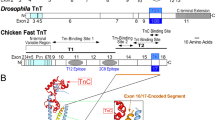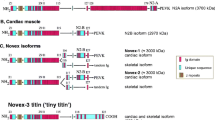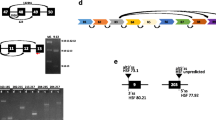Abstract
Titin is believed to play a major role in passive tension development in cardiac muscle. The cDNA sequence of cardiac titin in the I-band sarcomeric region was determined for several mammalian species. Contiguous sequences of 3749, 12,230, 6602, and 11,850 base pairs have been obtained for the rat N2B, rat N2BA, dog N2B, and dog N2BA isoforms respectively. The length of the PEVK region of the N2B isoform did not correlate with rest tension properties since the only species showing an altered length was the dog that expressed a shorter form. No differences were found between the N2B PEVK lengths in ventricular and atrial muscle. New N2BA splicing pathways in the first tandem Ig region were found in human and dog cardiac muscle. Most of the rat and dog sequences were 85–95% identical with the reported human sequence. However, the N2B unique amino acid sequences of rat and dog were only 51 and 67% identical to human. The rat N2B unique sequence was 526 amino acids in length compared to 572 in human. The difference in length was due to deletion of amino acid segments from six different regions of the N2B unique domain. Patterns of PEVK exon expression were also much different in the dog, human, and rat. Six separate dog N2BA PEVK clones were sequenced, and all had different exon splice combinations yielding PEVK lengths ranging from 703 to 900 amino acids. In contrast a rat N2BA clone had a PEVK length of 525 amino acids, while a human clone had an 908 amino acid PEVK segment. Thus, in addition to the higher proportion of the shorter N2B isoform found in rat compared with dog cardiac muscle observed previously, shorter N2B unique and N2BA PEVK segments may also contribute to the greater passive tension in cardiac muscle from rats.
Similar content being viewed by others
References
Altschul SF, Gish W, Miller W, Meyers EW and Lipman DJ (1990) Basic local alignment search tool. J Mol Biol 215: 403-410.
Bang ML, Centner T, Forno. F, Geach AJ, Gotthardt M, McNabb M, Witt CC, Labeit D, Gregorio CC, Granzier H and Labeit S (2001) The complete gene sequence of titin, expression of an unusual approximately 700-kDa titin isoform, and its interaction with obscurin identify a novel Z-line to I-band linking system. Circ Res 89: 1065-1072.
Cazorla O, Freiburg A, Helmes M, Centner T, McNabb M, Wu Y, Trombitas K, Labeit S and Granzier H (2000) Differential expression of cardiac titin isoforms and modulation of cellular stiffness. Circ Res 86: 59-67.
Chomczynski P (1993) A reagent for the single-step simultaneous isolation of RNA, DNA and protein from cell and tissue samples. Bio Techniques 15: 532-537.
Fabiato A and Fabiato F (1978) Myofilament-generated tension oscillations during partial calcium activation and activation dependence of the sarcomere length-tension relation of skinned cardiac cells. J Gen Physiol 72: 667-699.
Freiburg A, Trombitas K, Hell W, Cazorla O, Fougerousse F, Centner T, Kolmerer B, Witt C, Beckmann JS, Gregorio CC, Granzier H and Labeit S (2000) Series of exon-skip** events in the elastic spring region of titin as the structural basis for myofibrillar elastic diversity. Circ Res 86: 1114-1121.
Funatsu T, Higuchi H and Ishiwata S (1990) Elastic filaments in skeletal muscle revealed by selective removal of thin filaments with plasma gelsolin. J Cell Biol 110: 53-62.
Furst DO, Osborn M, Nave R and Weber K (1988) The organization of the titin filaments in the half-sarcomere revealed by monoclonal antibodies in immunoelectron microscopy: a map of ten nonrepetitive epitopes starting at the Z-line extends close to the M-line. J Cell Biol 106: 1563-1572.
Granzier HL and Irving TC (1995) Passive tension in cardiac muscle: contribution of collagen, titin, microtubules, and intermediate filaments. Biophys J 68: 1027-1044.
Granzier H and Labeit S (2002) Cardiac titin: an adjustable multifunctional spring. J Physiol (Lond) 541: 335-342.
Greaser M (2001) Identification of new repeating motifs in titin. Proteins 43: 145-149.
Gregorio CC, Granzier H, Sorimachi H and Labeit S (1999) Muscle assembly: a titanic achievement? Curr Opin Cell Biol 11: 18-25.
Helmes M, Trombitas K, Centner T, Kellermayer M, Labeit S, Linke WA and Granzier H (1999) Mechanically driven contour-length adjustment in rat cardiac titin's unique N2B sequence: titin is an adjustable spring. Circ Res 84: 1339-1352.
Higgins DG, Labeit S, Gautel M and Gibson TJ (1994) The evolution of titin and related giant muscle proteins. J Mol Evol 38: 395-404.
Horowits R and Podolsky RJ (1987) The positional stability of thick filaments in activated skeletal muscle depends on sarcomere length: evidence for the role of titin filaments. J Cell Biol 105: 2217-2223.
Labeit S and Kolmerer B (1995) Titins: giant proteins in charge of muscle ultrastructure and elasticity. Science 270: 293-296.
Linke WA and Granzier H (1998) A spring tale: new facts on titin elasticity. Biophys J 75: 2613-2614.
Linke WA, Ivemeyer M, Olivieri N, Kolmerer B, Ruegg JC and Labeit S (1996) Towards a molecular understanding of the elasticity of titin. J Mol Biol 261: 62-71.
Linke WA, Rudy DE, Centner T, Gautel M, Witt C, Labeit S and Gregorio CC (1999) I-band titin in cardiac muscle is a three-element molecular spring and is critical for maintaining thin filament structure. J Cell Biol 146: 631-644.
Marck C (1988) 'DNA Strider': a 'C' program for the fast analysis of DNA and protein sequences on the Apple Macintosh family of computers. Nucleic Acids Res 16: 1829-1836.
Maruyama K (1976) Connectin, an elastic protein from myofibrils. J Biochem (Tokyo) 80: 405-407.
Maruyama K (1997) Connectin/titin, a giant elastic protein of muscle. FASEB J 11: 341-345.
Tatusova TA and Madden TL (1999) BLAST 2 Sequences, a new tool for comparing protein and nucleotide sequences. FEMS Microbiol Lett 174: 247-250.
Trinick J and Tskhovrebova L (1999) Titin: a molecular control freak. Trends Cell Biol 9: 377-380.
Trombitas K, Freiburg A, Centner T, Labeit S and Granzier H (1999) Molecular dissection of N2B cardiac titin's extensibility. Biophys J 77: 3189-3196.
Trombitas K, Greaser M, Labeit S, ** JP, Kellermayer M, Helmes M and Granzier H (1998) Titin extensibility in situ: entropic elasticity of permanently folded and permanently unfolded molecular segments. J Cell Biol 140: 853-859.
Trombitas K, Redkar A, Centner T, Wu Y, Labeit S and Granzier H (2000) Extensibility of isoforms of cardiac titin: variation in contour length of molecular subsegments provides a basis for cellular passive stiffness diversity. Biophys J 79: 3226-3234.
Trombitas K, Wu Y, Labeit D, Labeit S and Granzier H (2001) Cardiac titin isoforms are coexpressed in the half-sarcomere and extend independently. Am J Physiol Heart Circ Physiol 281: H1793-H1799.
Wang K (1996) Titin/connectin and nebulin: giant protein rulers of muscle structure and function. Adv Biophys 33: 123-134.
Wang K, McClure J and Tu A (1979) Titin: major myofibrillar components of striated muscle. Proc Natl Acad Sci USA 76: 3698-3702.
Wang K, McCarter R, Wright J, Beverly J and Ramirez-Mitchell R (1991) Regulation of skeletal muscle stiffness and elasticity by titin isoforms: a test of the segmental extension model of resting tension. Proc Natl Acad Sci USA 88: 7101-7105.
Watanabe K, Nair P, Labeit D, Kellermayer MS, Greaser M, Labeit S and Granzier H (2002) Molecular mechanics of cardiac titin's PEVK and N2B spring elements. J Biol Chem 277: 11549-11558.
Witt CC, Olivieri N, Centner T, Kolmerer B, Millevoi S, Morell J, Labeit D, Labeit S, Jockusch H and Pastore A (1998) A survey of the primary structure and the interspecies conservation of I-band titin's elastic elements in vertebrates. J Struct Biol 122: 206-215.
Wu Y, Cazorla O, Labeit D, Labeit S and Granzier H (2000) Changes in titin and collagen underlie diastolic stiffness diversity of cardiac muscle. J Mol Cell Cardiol 32: 2151-2162.
Author information
Authors and Affiliations
Rights and permissions
About this article
Cite this article
Greaser, M.L., Berri, M., Warren, C.M. et al. Species variations in cDNA sequence and exon splicing patterns in the extensible I-band region of cardiac titin: relation to passive tension. J Muscle Res Cell Motil 23, 473–482 (2002). https://doi.org/10.1023/A:1023410523184
Issue Date:
DOI: https://doi.org/10.1023/A:1023410523184




